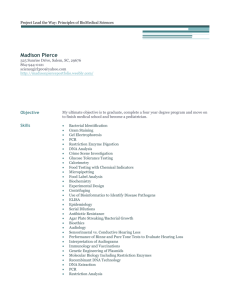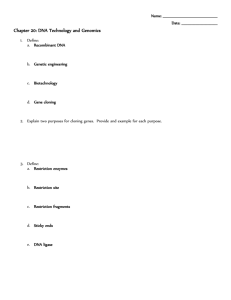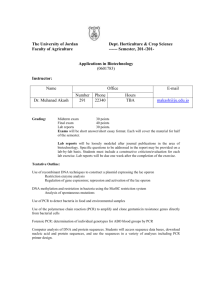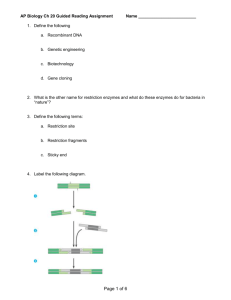Biotechnology
advertisement
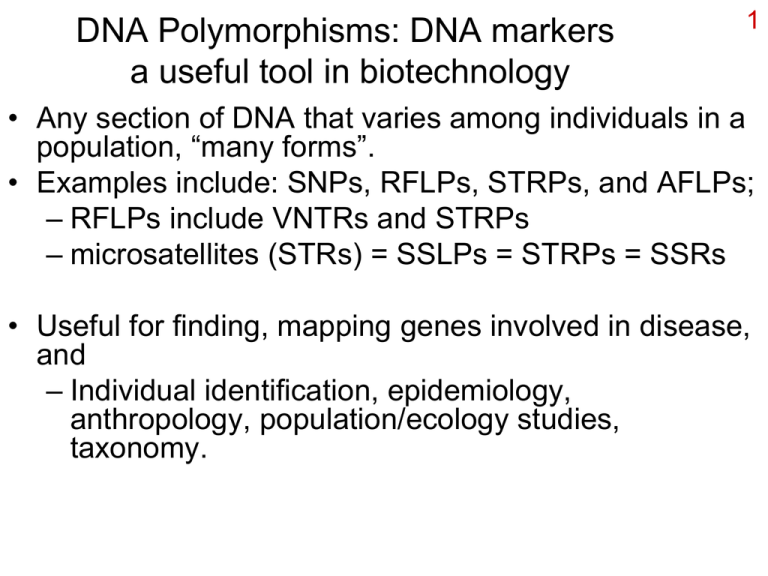
DNA Polymorphisms: DNA markers a useful tool in biotechnology 1 • Any section of DNA that varies among individuals in a population, “many forms”. • Examples include: SNPs, RFLPs, STRPs, and AFLPs; – RFLPs include VNTRs and STRPs – microsatellites (STRs) = SSLPs = STRPs = SSRs • Useful for finding, mapping genes involved in disease, and – Individual identification, epidemiology, anthropology, population/ecology studies, taxonomy. SNPs 2 Single nucleotide polymorphisms: regions of DNA where one base pair is different. Occur evenly spread over all the DNA. 1/ 1000-3000 bp Detected by sequencing. If SNP occurs in a restriction enzyme site, it generates an RFLP. Could be in coding or non-coding regions. Over 300,000 human SNPs known and are being mapped. 3 SNP RFLPs Restriction fragment length polymorphism. Mutation at a restriction site prevents recognition & cutting. Results in one band of larger DNA instead of 2 smaller ones. scidiv.bcc.ctc.edu/.../lectures/ DNATechnology/image021.jpg 4 Other RFLPs: VNTRs and STRPs Minisatellites and Microsatellites 5 • These are RFLPs because they are defined by or visible following restriction enzyme cuts. – Variable Number Tandem Repeats • Groups (10-100) of nucleotides repeated 2 – 100 times (depending on individual and locus). • Restriction sites on both sides of repeated DNA • The more repeats, the longer the fragment. – Simple Tandem Repeat Polymorphisms • Shorter, 2-9 nucleotides repeated • Small enough number for PCR amplification • Also called STRs, SSLPs, etc. Use of VNTRs Restriction sites are on either side; fragment length depends on number of repeats in between sites. 6 STRPs Primers for both sides of repeated region allow PCR amplification of DNA; generates PCR products that differ in length depending on number of repeats. Becoming the standard method for DNA testing in forensics labs. Cheaper, easier, more sensitive. 7 STRs in forensics • • • • • • • Locus vWA 14 0.081 15 0.107 15.2 0.179 16 0.306 17 0.192 18 0.089 19 0.047 Band frequency 8 Alleles in different ethnic and racial groups examined, used as database. Panel of 13 different STRs are used. Because the odds of a particular combination of the 13 is product of the frequencies, numbers like 1 in 10 billion can be generated. 9 THE 13 CODIS STRs African-American U.S. Caucasian D3S1358 0.102 0.078 vWA 0.058 0.065 FGA 0.035 0.036 TH01 0.102 0.094 TPOX 0.081 0.211 CSF1PO 0.070 0.122 D5S818 0.097 0.140 D13S317 0.131 0.074 D7S820 0.081 0.061 D8S1179 0.075 0.067 D21S11 0.033 0.045 D18S51 0.028 0.030 D16S539 0.066 0.103 STR http://expertpages.com/news/dna.htm RAPD: using PCR to find polymorphisms 10 • “Random amplified polymorphic DNA” • Screen DNA from individuals by doing PCR with random short primers. • By random chance, primers will amplify many different sections of DNA. • Look for bands on gel that are not present in each individual tested. avery.rutgers.edu/.../ archives/onions/rapd.html RAPD: using PCR to find polymorphisms-2 11

